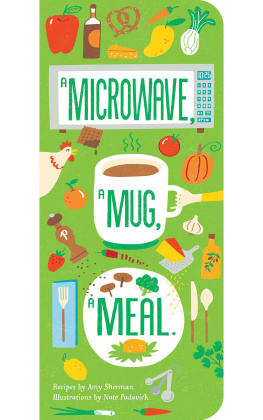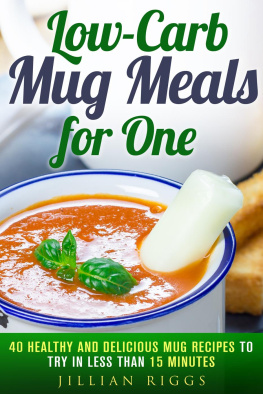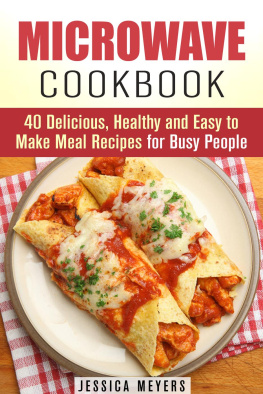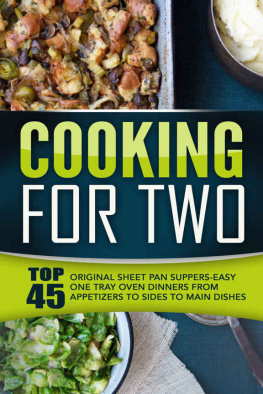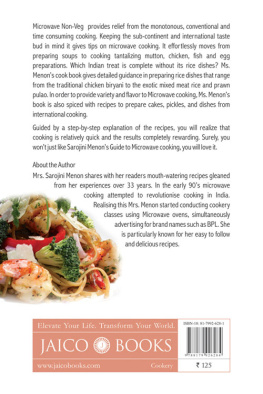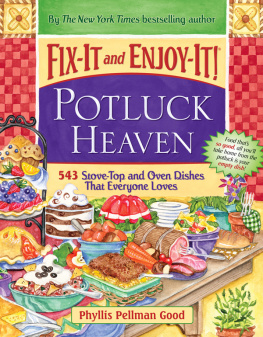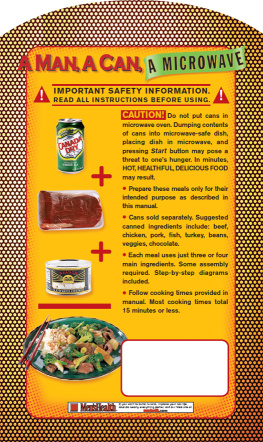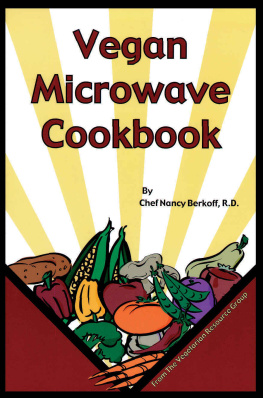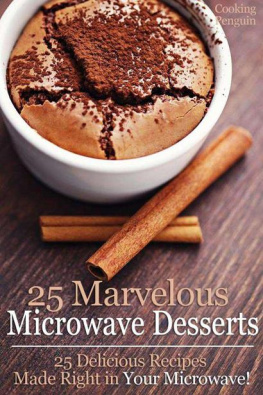A Microwave, A Mug, A Meal
Amy Sherman
Illustrations by Nate Padavick

A Microwave, A Mug, A Meal
Digital Edition 1.0
Text 2015 Amy Sherman
Illustrations 2015 Nate Padavick
All rights reserved. No part of this book may be reproduced by any means whatsoever without written permission from the publisher, except brief portions quoted for purpose of review.
Gibbs Smith
P.O. Box 667
Layton, Utah 84041
Orders: 1.800.835.4993
www.gibbs-smith.com
ISBN: 978-1-4236-3823-0
microwave cooking
Microwave ovens come in many different styles, sizes and power levels. A compact model may be 650 to 800 watts, while midsize and large ovens can range from 850 to 1,650 watts. You will need to adjust power levels for most recipes.
Undercook rather than overcook and allow carryover heat to do some of the work. Some recipes call for resting time. If you need to cook something longer, do so in 10-second intervals. Heat from the food makes the mug hot, so handle cautiously.
While a difference of 100 watts or so doesnt matter much in cooking, the ability to adjust the power level is crucial. Cook gently by reducing the power rather than always cooking at full blast. If you dont know the wattage of your microwave oven, heres an easy test to figure it out:

Fill a microwave-safe glass measuring cup with 1 liter (1000 ml) of tap water. Stir the water with a thermometer for 10 seconds and check the temperature-the water should be between 60 and 80 degrees F. Now remove the thermometer and place the measuring cup with the water in the microwave oven. Microwave for 33 seconds at full power.
Remove the measuring cup and immediately plunge the thermometer back into the water and check the temperature. Subtract the original number from the new number. Multiply that number by 100 and that is the wattage of your microwave oven. For example, if the water was 74 degrees F when you first measured it and 84 when it came out of the microwave, your magic number is 10, and you have a 1000-watt microwave.
global pantry staples
Stocking up on these inexpensive staples will help you to easily prepare great meals in very little time. If you cant find them in a local supermarket, look for them at a specialty gourmet retailer or online. Dont worry about investing in ingredients that you will only use once; each is used in multiple recipes.
chile paste: There are many different kinds of Asian chile pastes, some have garlic, some are brighter and fresher tasting and others are thick and a little bit salty. None are very expensive, so find one or two you like and stash them in the refrigerator. Use chile paste in sauces, glazes, dips and stews to add heat. In most recipes you can substitute Sriracha sauce for chile paste.
chipotle in adobo: Chipotle is a smoked jalapeo chile and adobo is the vinegar sauce. A little of this smoky, tangy ingredient goes a long way! Open a can of chipotle in adobo and use what you need, then store the rest of it in a ziplock bag in the freezer. Its great in sauces, stews and meatloaf recipes.
fish sauce: Asian fish sauce adds rich flavor that is very complex with toasty, sour, sweet and savory notes. Its used in Thai, Vietnamese and Laotian cuisine and is similar to Worcestershire sauce and soy sauce. After opening, store it in the refrigerator. Find it in the Asian section of the supermarket. Use it in soups, sauces and marinades.
miso: Fermented soybean paste doesnt sound very sexy, but miso is a luscious ingredient that lends creaminess and the savory flavor of umami to a variety of dishes. Choose both a white or shiro miso, which is mild and less salty, and a brown or red miso. Some, but not all, miso is gluten-free, so be sure to check the label if this is a concern. Use miso in soups, but also in salad dressings, sauces and gravy.
chinese sausage: These inexpensive, fully cooked sausages are very firm and sweet. They add a lot of flavor to simple dishes. They are shelf stable until you open the package, and they are easy to find in Asian markets or online. The Cantonese name for them is Lap cheong . After opening the package, store sausages in the freezer.
spanish chorizo: This dry sausage is packed with smoky, sweet and hot paprika, but also subtler notes of garlic and black pepper. Its already cooked and does not need to be refrigerated.
panko: These Japanese bread crumbs have a rough texture and are extremely crisp. They are available in white and whole wheat and are generally interchangeable.
master recipes
bulgur
This wheat steams up quickly and can be used in main dishes and salads.
Combine 1/4 cup bulgur, 5 tablespoons water, and a pinch of salt in the mug. Cover with plastic wrap, vent, and microwave for 7 minutes at 300 watts. Let rest, covered, for 3 minutes, or until tender but slightly chewy. Fluff with a fork. This makes a little over 1/2 cup.
quinoa
This versatile high-protein ingredient acts like a grain. Its great in salads or instead of rice. Dont forget to rinse it, as it can have a bitter flavor.
To make a single 1/3-cup portion, rinse 3 tablespoons of quinoa in a small strainer, then drain. Combine the rinsed quinoa with 3 tablespoons of water in the mug, cover with plastic wrap, and vent. Microwave for 12 minutes at 200 watts, remove cover, add 2 tablespoons of water, re-cover, and microwave for 3 minutes at 500 watts. Let rest for 2 minutes, fluff with a fork, and serve. Quinoa should be light and fluffy with a little crunchy pop.
ramen noodles
Instant ramen noodles cook up quickly in the microwave oven. Look for a high-quality brand that is low in fat, and dont use the seasoning packet, which is generally high in sodium and monosodium glutamate (MSG). Cook half of the packet for one serving. Place 1/2 of the noodles and 1/2 of the water in a soup mug, cover with plastic wrap, and vent. Microwave for 2 minutes at 1000 watts, stir, and then cover again and microwave 1 minute longer. Drain Cooking time may vary depending on the brand.

